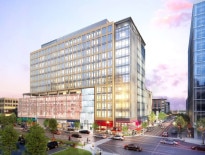Homeownership rates among black Americans were disproportionately affected by the mortgage crisis and have recovered more slowly than other groups. Advocates say removing barriers to black homeownership is fair, profitable and the key to increasing access to the American dream for all.
The National Association of Real Estate Agents (NAREB) was founded in 1947 as an “equal opportunity and civil rights advocacy organization for African-American real estate professionals, consumers and communities.” The group is similar to NAR, but NAREB members, called Realtists, are primarily, though not exclusively, black.
NAREB’s 2017 State of Housing in Black America (SHIBA) report found black homeownership rates have recently shown signs of modest improvement, but it’s too soon to declare victory.
“The black homeownership rate rose from its near 50-year low of 41.3 in the third quarter of 2016 to above 42 percent in the first two quarters of 2017. Although this is an insufficient time period to determine whether we are observing a rising trend,” according to the report.
A 2017 report from the Urban Institute confirmed the narrative.
“In the three decades after the Fair Housing Act passed [in 1968], black homeownership rose by almost 6 percentage points,” the report found. “But from 2000 to 2015, that gain was more than erased as forces within and beyond the housing market aligned to reduce the black homeownership rate to 41.2 percent.”
Breaking Down Barriers
The SHIBA report identifies three major obstacles keeping many potential black homebuyers from becoming homeowners: the high cost of loans, the high cost of real estate and the lack of lenders in black communities.
According to the SHIBA report, “between 2008 and 2012, the FDIC closed, forced sales or liquidated 466 commercial banks, many of which were black-owned. By August 2014, there were only 21 black-owned banks left in the U.S. With bank closings in communities of color have gone a significant number of the loan officers, originators and underwriters who were familiar with those communities.”
Mortgages are often more expensive for black applicants because they tend to have low credit scores, said Richard Phipps, CEO of CFS Realty in Roslindale and a regional vice president of NAREB.
“The average credit score for black applicants is about 580,” Phipps said. “Programs promulgated by the GSEs and FHA say they can approve borrowers with credit scores of 580. However, lenders always overlay additional requirements on top of the FHA requirements in such a way that they filter out clients that don’t meet their sweet spot requirements.”
Phipps spends a lot of time teaching prospective buyers how to build and repair their credit, but most agents don’t. Low credit scores translate to higher interest rates, pushing homeownership out of reach for marginal buyers in the expensive Boston market.
While most people blame sub-prime lending for the collapse of the economy, Richard Taylor, director of the Suffolk University Center for Real Estate, said when those loans were made responsibly they served their intended purpose: turning marginal borrowers into homeowners.
“A lot of no-doc loans went to people with less than stellar credit [who] were still bankable,” Taylor said. “Those products have gone away. That’s going to knock a lot of people out of the housing market, including some
African-Americans.”
Credit ratings agencies should upgrade their models and lenders should allow for a higher percentage of an applicant’s income to be allocated for housing, especially in expensive markets like Boston, Taylor said, adding that low inventory is keeping home prices high and investors are compounding the problem.
“I’m seeing in Greater Boston that there are sophisticated investors who are pooling money and buying property in Roxbury, Dorchester and Mattapan,” Taylor said. “Now there is a competitive fight for property that would have been available for a family. It would help if the banks could look for neighborhood buyers and help them back into properties.”
Trying To Turn The Tide
“The black homeownership rate has declined steadily since 2004,” Ron Cooper, 2016 president of NAREB, said in the SHIBA report. “We’re raising the alert that we need to do something to increase homeownership.”
Unless significant changes occur, current predictions “suggest that black homeownership will continue trending downward to 41 percent of black households in 2020, and 40 percent in 2030,” according to a 2017 Freddie Mac report.
“NAREB is currently implementing our ‘2 million in 5’ initiative,” Phipps said. “We want to get 2 million black people into homes in five years. That makes money for everybody, regardless of their skin color. We know it’s ambitious, but we think of this as a way to help people in the black community and a way institutions can increase profits.”
A recent study from the National Association of Home Builders found in the year after buying a home, homeowners spend an average of $10,601 on repairs, furniture, redecorating and all the other aspects of turning a house into a home. Ideally that pumps money into the local economy, where it supports the entire community.
“We’re not talking about a black problem,” Phipps said. “We’re talking about an economic problem that we’re trying to resolve. It’s really a great business opportunity. A rising tide lifts all boats.”







